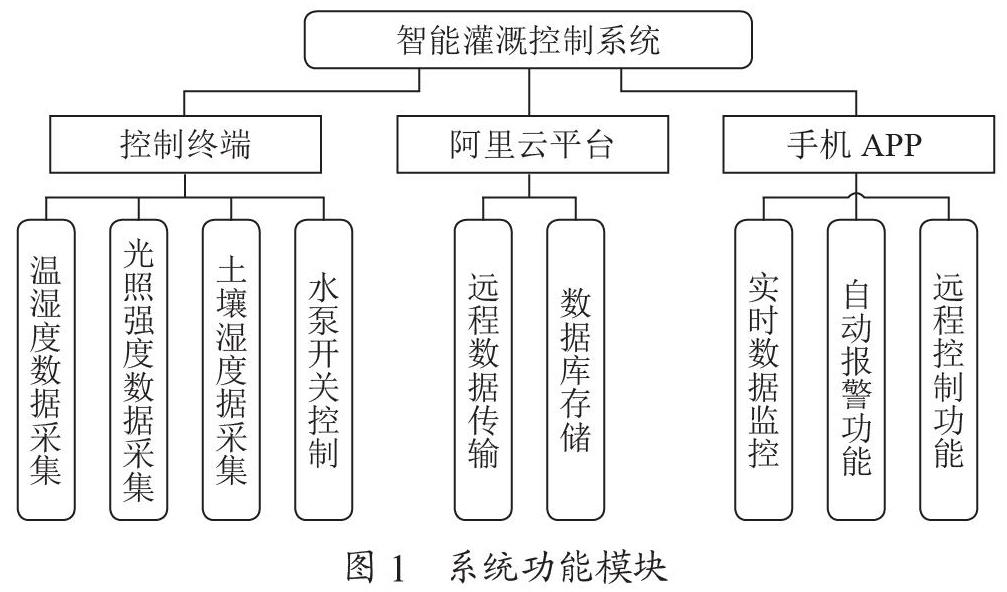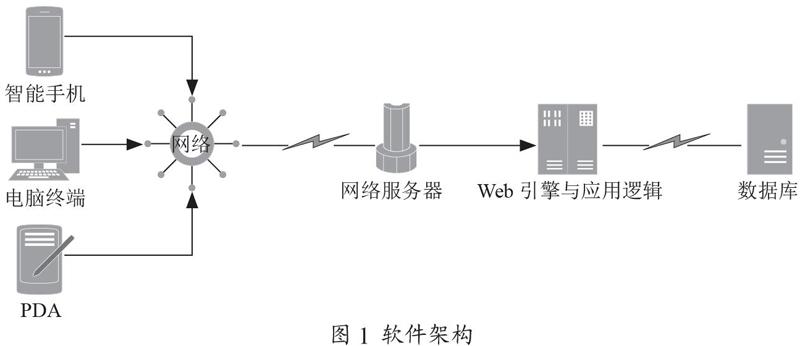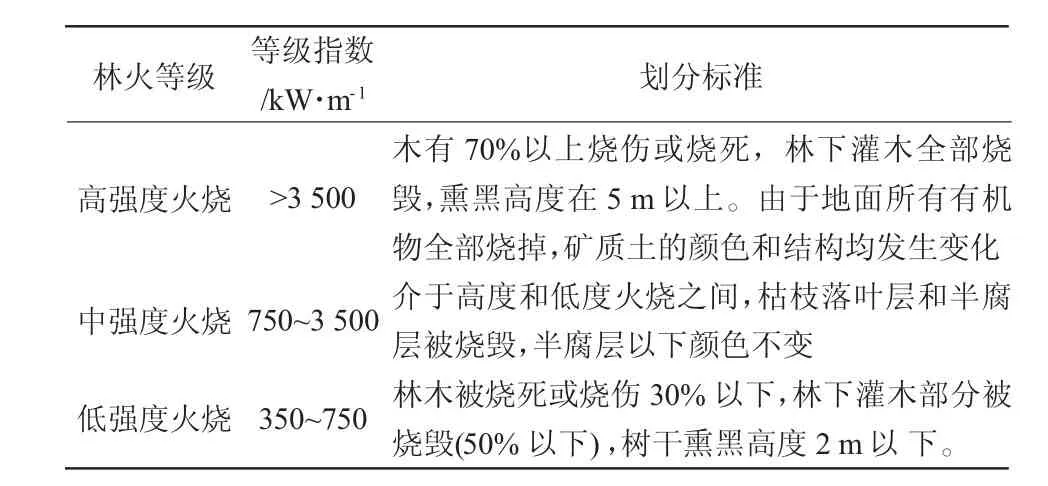摘要:【目的】探究低能耗组装式深冬生产型日光温室对室内土壤环境的影响,为该新型日光温室越冬茬作物栽培以及环境控制提供数据支持。【方法】研究选取低能耗组装式深冬生产型日光温室(新型日光温室)为试验温室,普通砖墙结构日光温室为对照温室,分析试验温室和对照温室的主要土壤环境之间的差异,并结合对土壤进行分层研究的方法,确定起主导作用的因子。【结果】新型日光温室相对于砖墙日光温室,其夜间室内表层土壤温度提高 3 0 . 1 % , - 5 0 ~ - 6 0 c m 土壤温度提高 2 0 . 8 5 % ,新型日光温室土壤温度均显著高于砖墙结构日光温室(  )。新型日光温室不同土壤深度的含水量相对于传统温室,均显著降低( P lt; 0 . 0 5 ) ,在
)。新型日光温室不同土壤深度的含水量相对于传统温室,均显著降低( P lt; 0 . 0 5 ) ,在 土壤深度时,新型日光温室土壤含水量降低 1 1 % ;在 - 2 0 c m 土壤深度时,新型日光温室土壤含水量1 3 . 2 9 % ;在 - 3 0 c m 王壤深度时,新型日光温室土壤含水量降低 2 . 6 8 % ;在 - 4 0 c m 王壤深度时,新型日光温室土壤含水量降低 6 . 6 3 % ;在
土壤深度时,新型日光温室土壤含水量降低 1 1 % ;在 - 2 0 c m 土壤深度时,新型日光温室土壤含水量1 3 . 2 9 % ;在 - 3 0 c m 王壤深度时,新型日光温室土壤含水量降低 2 . 6 8 % ;在 - 4 0 c m 王壤深度时,新型日光温室土壤含水量降低 6 . 6 3 % ;在  土壤深度时,新型日光温室土壤含水量降低 8 . 0 7 % ;在 - 6 0 c m 土壤深度时,新型日光温室土壤含水量降低 1 0 . 7 4 % 。新型日光温室较传统温室,其深层土壤总氮含量提高2 1 . 2 6 % ,土壤总碳含量提高 1 2 . 0 7 % ,土壤无机氮含量提高 1 9 . 9 5 % 。【结论】新型日光温室在冬季夜间拥有更高的土壤温度与更低的土壤湿度。同时,新型日光温室在控制氮素等元素淋溶迁移方面相较于传统日光温室也有明显改变,更好地保持耕作层土壤肥力,也在一定程度上减少对深层土壤以及地下水的破坏,促进设施农业的绿色发展。
土壤深度时,新型日光温室土壤含水量降低 8 . 0 7 % ;在 - 6 0 c m 土壤深度时,新型日光温室土壤含水量降低 1 0 . 7 4 % 。新型日光温室较传统温室,其深层土壤总氮含量提高2 1 . 2 6 % ,土壤总碳含量提高 1 2 . 0 7 % ,土壤无机氮含量提高 1 9 . 9 5 % 。【结论】新型日光温室在冬季夜间拥有更高的土壤温度与更低的土壤湿度。同时,新型日光温室在控制氮素等元素淋溶迁移方面相较于传统日光温室也有明显改变,更好地保持耕作层土壤肥力,也在一定程度上减少对深层土壤以及地下水的破坏,促进设施农业的绿色发展。
中图分类号:S625 文献标志码:A 文章编号:1001-4330(2025)02-0436-10
0 引言
【研究意义】全球设施农业中日光温室众多[1]。日光温室作为一个封闭或半封闭的热力学系统,其室内环境不仅受室外温度、湿度、太阳辐射、风速等因素的影响,还会受到土壤蒸发、土壤温度变化等对温室内部环境的影响[2]。其中日光温室的土壤环境与温室作物生长有着直接联系,由于温室土壤环境差异造成的温室环境变化对于冬季日光温室内环境的调控具有重要影响[3-6] 0因此掌握温室内土壤环境的变化规律,对改进更适宜于当地气候特征温室结构、提高温室作物产量和病虫害防效具有重要意义[]。【前人研究进展近些年来,越来越多的地区开始使用组装式的新材料日光温室[8],但是较之传统的砖墙结构温室,新材料温室可以有良好的保温性,但无很好的蓄热性,尤其是种植作物封行后,土壤接收不到直射光,土壤温度逐渐降低,不能长时间给温室夜间供热,土壤温度和空气温度还会逐步下降,尤其是在连阴天温度更低[10-13]。所以很多新材料温室并不能在深冬生产[14]。【本研究切入点】低能耗组装式深冬生产型日光温室(以下简称新型日光温室)作为一种新的温室类型,其不仅仅可以显著提高冬季夜间温室室内空气温度,保证深冬时期作物的正常生长发育。需研究新型日光温室利用其装备的主被动蓄放热装置有效地利用昼间温室室内最高温时多余的空气热量,使其可以在冬季夜间为温室土壤进行加热,以解决冬季日光温室土壤温度不足的问题。【拟解决的关键问题】研究深冬时期新型日光温室土壤环境变化,分析2种日光温室即新型日光温室和普通砖混结构日光温室(以下简称传统温室),对温室土壤环境的影响,探索新疆地区日光温室作物冬季管理方法。
材料与方法
1.1 材料
试验样地位于新疆喀什地区叶城县洛克乡 ,为典型的暖温带大陆性干旱气候,年均蒸发量 2 4 8 0 m m ,全年日照 2 7 4 2 h ,平均无霜期为 2 2 8 d 。年平均气温
,为典型的暖温带大陆性干旱气候,年均蒸发量 2 4 8 0 m m ,全年日照 2 7 4 2 h ,平均无霜期为 2 2 8 d 。年平均气温  ,年极端最高气温
,年极端最高气温  ,极端最低气温
,极端最低气温  。
。
试验温室长 1 0 0 m ,前后跨度 1 0 m ,脊高为5 . 1 m ,该温室为新型日光温室,温室装备有主被动蓄热供热装置,采用部件组装式架构、现代保温材料。对照温室为普通砖墙结构日光温室,温室长 1 0 0 m ,前后跨度 1 0 m ,脊高为 3 . 6 m 。
1.2 方法
1.2.1 试验设计
低能耗组装式深冬生产型日光温室是一种新的温室类型,由新材料代替传统墙体结构,采用内保温形式。新型日光温室装机容量18.18KW,全部为二级负荷,其供热装置为主被动蓄热供热装置[15-18],代替了传统的燃煤加热装置,新型日光温室相比于传统温室其能耗指标折标煤量显著降低。主动蓄热供热装置采用高温空气能热泵技术,当温室内空气温度上升到  时开启热泵,将温室内的高温空气的热量转换成热水通过地暖管给土壤加温,低于 2 0 % 停止;当晚上空气温度低于
时开启热泵,将温室内的高温空气的热量转换成热水通过地暖管给土壤加温,低于 2 0 % 停止;当晚上空气温度低于  时开始从土壤中提取热量给空气加温;白天晚上反复循环运行,可以保持土壤比较高的温度和空气温度,可以满足喜温蔬菜越冬生产,尤其在深冬连阴天也可以维持一定的温度,保证温室内植物的正常生长[19-23]。试验地位于新疆南疆戈壁,土壤持水能力差,灌溉用水量过大。因此,新型日光温室在建设初期在地下 6 0 c m 处铺设有防水透气薄膜层。图1
时开始从土壤中提取热量给空气加温;白天晚上反复循环运行,可以保持土壤比较高的温度和空气温度,可以满足喜温蔬菜越冬生产,尤其在深冬连阴天也可以维持一定的温度,保证温室内植物的正常生长[19-23]。试验地位于新疆南疆戈壁,土壤持水能力差,灌溉用水量过大。因此,新型日光温室在建设初期在地下 6 0 c m 处铺设有防水透气薄膜层。图1
 图1低能耗组装式深冬生产型日光温室主动蓄热供热装置与温室内暖管布置示意 Fig. 1Layout diagram of new assembled solar greenhouse active heating deviceand heatingpipein thegreenhouse
图1低能耗组装式深冬生产型日光温室主动蓄热供热装置与温室内暖管布置示意 Fig. 1Layout diagram of new assembled solar greenhouse active heating deviceand heatingpipein thegreenhouse1.2.2 监测指标
选取于2023年1月对新型日光温室与普通砖墙式日光温室土壤进行检测。研究在温室内其中3个截面中设置7个不同土壤深度的温度监测,分别为  和-60c m 。设置了6个不同深度的土壤水分检测分别为 - 1 0 , - 2 0 , - 3 0 , - 4 0 , - 5 0 和
和-60c m 。设置了6个不同深度的土壤水分检测分别为 - 1 0 , - 2 0 , - 3 0 , - 4 0 , - 5 0 和  。采取温室中心截面的传感器数据进行分析。研究将从三层土壤深度(表层土壤:
。采取温室中心截面的传感器数据进行分析。研究将从三层土壤深度(表层土壤:  ;中层土壤:10~ 4 0 c m ;深层土壤:
;中层土壤:10~ 4 0 c m ;深层土壤:  ),分别进行土壤基础理化指标的测定。图2
),分别进行土壤基础理化指标的测定。图2
在移苗前(2023年1月6~9日),对2种温室土壤含水量进行标平处理,二者不同深度的土壤含水量差值 ⩽ 5 % 。2种日光温室种植作物为番茄,采用龚内双列形式栽培,每植株间距35c m 。施用肥料为尿素、硫酸钾、磷酸二铵,施用量参考当地常规用量。2种温室土壤基底以及试验施肥量保持一致,并对2种日光温室土壤基底测定背景值。表1
Na:普通砖墙结构日光温室 b:新型结构组装式深冬生产日光温室5.1m华意意意 意意意441 单位:m 单位:m不同深度温度与水分传感器 不同深度温度与水分传感器
 表12种日光温室土壤理化指标背景值Tab.1 Comparison of the two environmental factors of the solar greenhouse
表12种日光温室土壤理化指标背景值Tab.1 Comparison of the two environmental factors of the solar greenhouse1.3 数据处理
试验原始数据均先经过MicrosoftExcel程序整理,采用IBMSPSSStatistics26软件进行数据分析,采用Origin2022软件进行作图。利用可重复测量方差分析(RepeatedANOVA)检验2种日光温室对土壤温度、含水量、总氮、总碳、无机氮、净氮矿化速率的显著性影响。  表示具有显著性影响。
表示具有显著性影响。
2 结果与分析
2.1 不同温室土壤环境因子监测
2. 1. 1 不同日光温室土壤温度
研究表明,在冬季夜间最低温时,2种日光温室不同深度的土壤温度均高于  ,其中新型日光温室 0 ~ 6 0 c m 的不同深度土壤温度均值为10.47、12.20、12.89、12.31、12.22、12.11和
,其中新型日光温室 0 ~ 6 0 c m 的不同深度土壤温度均值为10.47、12.20、12.89、12.31、12.22、12.11和 ;砖墙结构日光温室
;砖墙结构日光温室  的不同深度土壤温度均值为8.05、11.03、11.68、10.79、10.67、10.02和
的不同深度土壤温度均值为8.05、11.03、11.68、10.79、10.67、10.02和  。
。
冬季夜间最低温时,在  土壤深度,2种温室土壤温度差异最显著,新型日光温室相对于砖墙日光温室,其土壤温度提高 3 0 . 1 % 。其次为
土壤深度,2种温室土壤温度差异最显著,新型日光温室相对于砖墙日光温室,其土壤温度提高 3 0 . 1 % 。其次为 与
与  土壤深度时,其土壤温度分别提高 2 0 . 8 5 % 和 2 5 . 4 4 % 。新型日光温室土壤温度均显著高于砖墙结构日光温室(
土壤深度时,其土壤温度分别提高 2 0 . 8 5 % 和 2 5 . 4 4 % 。新型日光温室土壤温度均显著高于砖墙结构日光温室(  。
。
在冬季昼间最高温时,新型日光温室 0 ~ 6 0 cm的不同深度土壤温度均值为20.90、13.29、11.54、11.84、13.32、13.28和  ;砖墙结构日光温室 0 ~ 6 0 c m 的不同深度土壤温度均值为28.34、16.61、10.57、10.87、12.18、12.14和
;砖墙结构日光温室 0 ~ 6 0 c m 的不同深度土壤温度均值为28.34、16.61、10.57、10.87、12.18、12.14和 。
。
冬季昼间最高温时,在  土壤深度,2种温室土壤温度差异最显著,新型日光温室相对于砖墙日光温室,其土壤温度降低 3 5 . 6 % 。其次为
土壤深度,2种温室土壤温度差异最显著,新型日光温室相对于砖墙日光温室,其土壤温度降低 3 5 . 6 % 。其次为 土壤深度时,其土壤温度降低 2 4 . 9 8 % 。新型日光温室
土壤深度时,其土壤温度降低 2 4 . 9 8 % 。新型日光温室  土壤温度显著低于砖墙结构日光温室( ⋅ P lt; 0 . 0 5 )。在冬季昼间最高温时,新型日光温室 - 2 0 ~ - 6 0 c m 的土壤温度均高于砖墙日光温室,但是其差异不显著。图3
土壤温度显著低于砖墙结构日光温室( ⋅ P lt; 0 . 0 5 )。在冬季昼间最高温时,新型日光温室 - 2 0 ~ - 6 0 c m 的土壤温度均高于砖墙日光温室,但是其差异不显著。图3
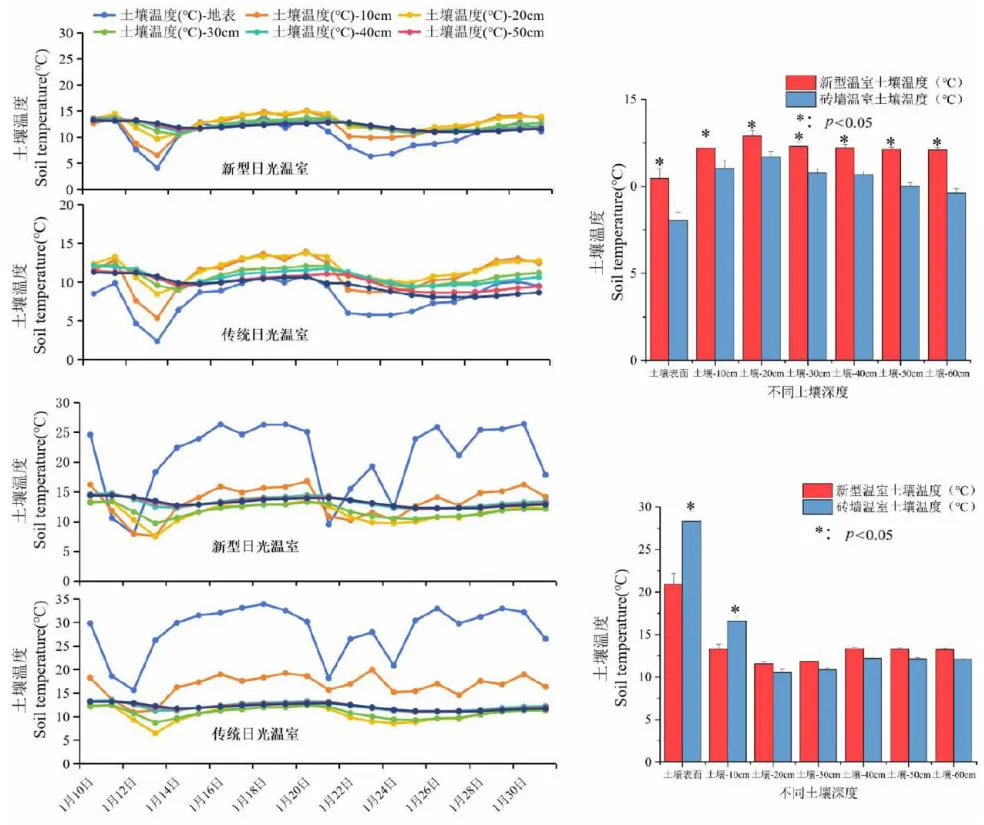 图32种日光温室冬季不同深度土壤温度动态Fig.3Dynamic diagram of soil temperature at different depths at night in winter intwokindsofsolargreenhouses
图32种日光温室冬季不同深度土壤温度动态Fig.3Dynamic diagram of soil temperature at different depths at night in winter intwokindsofsolargreenhouses2. 1.2 不同日光温室土壤水分变化
研究表明,2种温室含水量随时间变化不显著,且这种差异随着土壤深度的增加呈减少。研究发现在试验期间,新型日光温室不同土壤深度土壤含水量均低于传统温室,在  土壤深度时,新型日光温室土壤含水量均值为 7 . 6 1 % ,较传统温室土壤含水量 8 . 5 0 % ,降低了 1 1 % ;在- 2 0 c m 土壤深度时,新型日光温室土壤含水量均值为 9 . 2 0 % ,较传统温室土壤含水量 1 0 . 6 1 % ,降低了 1 3 . 2 9 % ;在 - 3 0 c m 土壤深度时,新型日光温室土壤含水量均值为 1 5 . 9 7 % ,较传统温室土壤含水量 1 6 . 4 1 % ,降低了 2 . 6 8 % ;在 - 4 0 c m 土壤深度时,新型日光温室土壤含水量均值为1 4 . 3 6 % ,较传统温室土壤含水量 1 5 . 3 8 % ,降低了 6 . 6 3 % ;在
土壤深度时,新型日光温室土壤含水量均值为 7 . 6 1 % ,较传统温室土壤含水量 8 . 5 0 % ,降低了 1 1 % ;在- 2 0 c m 土壤深度时,新型日光温室土壤含水量均值为 9 . 2 0 % ,较传统温室土壤含水量 1 0 . 6 1 % ,降低了 1 3 . 2 9 % ;在 - 3 0 c m 土壤深度时,新型日光温室土壤含水量均值为 1 5 . 9 7 % ,较传统温室土壤含水量 1 6 . 4 1 % ,降低了 2 . 6 8 % ;在 - 4 0 c m 土壤深度时,新型日光温室土壤含水量均值为1 4 . 3 6 % ,较传统温室土壤含水量 1 5 . 3 8 % ,降低了 6 . 6 3 % ;在  土壤深度时,新型日光温室土壤含水量均值为 1 6 . 6 3 % ,较传统温室土壤含水量 1 8 . 0 9 % ,降低了 8 . 0 7 % ;在
土壤深度时,新型日光温室土壤含水量均值为 1 6 . 6 3 % ,较传统温室土壤含水量 1 8 . 0 9 % ,降低了 8 . 0 7 % ;在  土壤深度时,新型日光温室土壤含水量均值为16. 12 % ,较传统温室土壤含水量 1 8 . 1 5 % ,降低了1 0 . 7 4 % 。新型日光温室
土壤深度时,新型日光温室土壤含水量均值为16. 12 % ,较传统温室土壤含水量 1 8 . 1 5 % ,降低了1 0 . 7 4 % 。新型日光温室  和
和  土壤深度的含水量相较于传统温室,均显著降低(
土壤深度的含水量相较于传统温室,均显著降低(  。图4
。图4
2.2 不同温室土壤理化指标
研究表明,新型日光温室表层土壤总氮含量为0 . 1 5 9 % ,传统温室表层土壤总氮含量为 0 . 1 5 1 % ,二者差异不显著(  。新型日光温室中层土壤总氮含量为 0 . 1 6 8 % ,传统温室中层土壤总氮含量为 0 . 1 6 9 % ,二者差异不显著( P gt; 0 . 0 5 。新型日光温室深层土壤总氮含量为 0 . 2 1 1 % ,传统温室深层土壤总氮含量为 0 . 1 7 4 % ,新型日光温室较传统温室,其深层土壤总氮含量提高 2 1 . 2 6 % ,二者差异显著( ( P lt; 0 . 0 5 ) 。
。新型日光温室中层土壤总氮含量为 0 . 1 6 8 % ,传统温室中层土壤总氮含量为 0 . 1 6 9 % ,二者差异不显著( P gt; 0 . 0 5 。新型日光温室深层土壤总氮含量为 0 . 2 1 1 % ,传统温室深层土壤总氮含量为 0 . 1 7 4 % ,新型日光温室较传统温室,其深层土壤总氮含量提高 2 1 . 2 6 % ,二者差异显著( ( P lt; 0 . 0 5 ) 。
新型日光温室表层土壤总碳含量为1 . 6 6 8 % ,传统温室表层土壤总碳含量为1 . 6 5 9 % ,二者差异不显著(  。新型日光温室中层土壤总碳含量为 1 . 7 2 5 % ,传统温室中层土壤总碳含量为 1 . 7 5 3 % ,二者差异不显著( P gt; 0 . 0 5 )。新型日光温室深层土壤总碳含量为1 . 9 5 9 % ,传统温室深层土壤总碳含量为1 . 7 4 8 % ,新型日光温室较传统温室,其深层土壤总碳含量提高 1 2 . 0 7 % ,二者差异不显著( P lt; 0.05)。
。新型日光温室中层土壤总碳含量为 1 . 7 2 5 % ,传统温室中层土壤总碳含量为 1 . 7 5 3 % ,二者差异不显著( P gt; 0 . 0 5 )。新型日光温室深层土壤总碳含量为1 . 9 5 9 % ,传统温室深层土壤总碳含量为1 . 7 4 8 % ,新型日光温室较传统温室,其深层土壤总碳含量提高 1 2 . 0 7 % ,二者差异不显著( P lt; 0.05)。
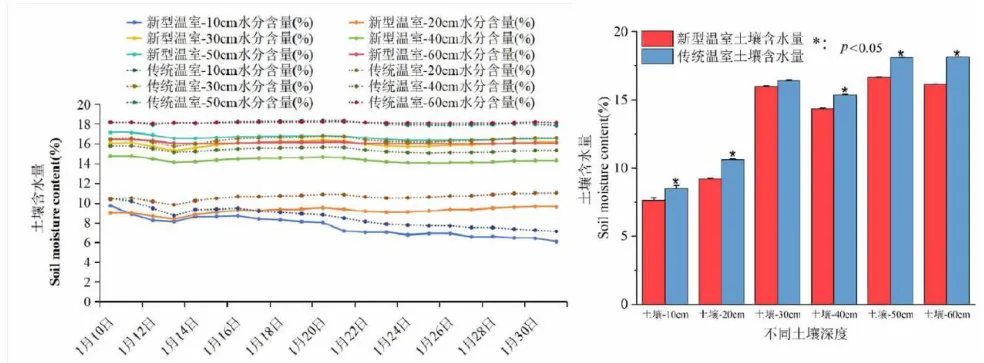 图42种日光温室冬季不同深度土壤含水量动态Fig. 4Dynamic diagram of soil water content at different depths of the two solargreenhousesinwinter
图42种日光温室冬季不同深度土壤含水量动态Fig. 4Dynamic diagram of soil water content at different depths of the two solargreenhousesinwinter新型日光温室表层土壤孔隙含水量为5 5 . 2 5 % ,传统温室表层土壤孔隙含水量为6 4 . 7 2 % ,新型日光温室较传统温室,其深层土壤孔隙含水量降低 1 4 . 6 3 % ,二者差异显著( P lt; 0.05)。新型日光温室中层土壤孔隙含水量为5 5 . 2 3 % ,传统温室中层土壤孔隙含水量为6 4 . 2 8 % ,新型日光温室较传统温室,其深层土壤孔隙含水量降低 1 4 . 0 8 % ,二者差异显著( P lt; 0.05)。新型日光温室深层土壤孔隙含水量为5 4 . 6 9 % ,传统温室深层土壤孔隙含水量为6 5 . 3 3 % ,新型日光温室较传统温室,其深层土壤孔隙含水量降低了 1 6 . 2 8 % ,二者差异显著( P lt; 0.05)。
新型日光温室表层土壤无机氮含量为1 3 3 . 2 8 m g / k g ,传统温室表层土壤无机氮含量为
1 2 9 . 7 5 m g / k g ,二者无显著差异( P gt; 0 . 0 5 。新型日光温室中层土壤无机氮含量为 1 5 3 . 8 1 m g/  ,传统温室中层土壤无机氮含量为 1 4 1 . 6 8 m g /
,传统温室中层土壤无机氮含量为 1 4 1 . 6 8 m g /  ,二者差异不显著(
,二者差异不显著(  。新型日光温室深层土壤无机氮含量为 1 9 4 . 6 2 m g / k g ,传统温室深层土壤无机氮含量为 1 6 2 . 2 5 m g / k g ,新型日光温室较传统温室,其深层土壤无机氮含量提高1 9 . 9 5 % ,二者差异显著(
。新型日光温室深层土壤无机氮含量为 1 9 4 . 6 2 m g / k g ,传统温室深层土壤无机氮含量为 1 6 2 . 2 5 m g / k g ,新型日光温室较传统温室,其深层土壤无机氮含量提高1 9 . 9 5 % ,二者差异显著(  。
。
新型日光温室较传统温室,在其土壤表层与土壤中层中,总氮、总碳和无机氮含量较传统温室均无显著提高趋势,但是在土壤深层中,总氮、总碳以及无机氮含量均呈显著提高趋势,并且研究还发现无论是新型日光温室还是传统温室,总氮、总碳以及无机氮含量均随着土壤深度的增加成一定的增加趋势。图5
新型温室土壤WFPS 传统温室土壤WFPS新型温室土壤总氮 传统温室土壤总氮 :Plt;0.050.25 70*:Plt;0.05 * * 中0.2 60 三
氮 三 400.1 30200.05100 0表层土壤(0-20cm)中层土壤(20-40cm)深层土壤(40-60cm) 表层土壤(0-20cm)中层土壤(20-40cm)深层土壤(40-60cm)■新型温室土壤总碳 传统温室土壤总碳 ■新型温室土壤无机氮 传统温室土填无机氮*:Plt;0.05 *:Plt;0.052.5 2502 T 中
资新王 m 王 150 11 1000.5 500表层土壤(020cm)中层土壤(2040cm)深层土壤(4060cm) 表层土壤(0-20cm) 中层土壤(20-40cm)深层土壤(40-60cm)
2.3 新型日光温室土壤环境变量相关性
研究表明,新型日光温室深层土壤温度与土壤含水量、土壤总氮、土壤总碳以及土壤无机氮含量的相关系数分别为  和
和 ,与土壤含水量存在显著的负相关关系,与土壤无机氮含量存在显著正相关关系。土壤含水量与土壤总氮、土壤总碳以及土壤无机氮含量的相关系数分别为
,与土壤含水量存在显著的负相关关系,与土壤无机氮含量存在显著正相关关系。土壤含水量与土壤总氮、土壤总碳以及土壤无机氮含量的相关系数分别为  和
和  ,与土壤总氮、土壤总碳以及土壤无机氮含量存在显著正
,与土壤总氮、土壤总碳以及土壤无机氮含量存在显著正
相关关系。
土壤温度和土壤含水量与其他土壤因子之间存在显著的相关关系,新型日光温室主导土壤环境的关键因子为土壤温度与土壤含水量,而土壤含水量也在一定程度上受到土壤温度的影响。新型日光温室相对于传统温室,其优势性就体现在保温性能以及主被动蓄放热系统能够在夜间对土壤进行加热,用以保持一个相对稳定合适的土壤温度环境。表2
 表2 新型日光温室土壤理化指标相关性Tab.2Correlation of physicochemical indexes of soil in the new solar greenhouse注:*表示具有显著相关性,
表2 新型日光温室土壤理化指标相关性Tab.2Correlation of physicochemical indexes of soil in the new solar greenhouse注:*表示具有显著相关性,  Notes:*indicatesa significant correlation,
Notes:*indicatesa significant correlation, 
3讨论
3.1研究结果显示,新型日光温室夜间土壤温度显著高于砖墙结构日光温室,然而在昼间,其表层土壤温度却低于砖墙结构日光温室。研究认为造成这种现象的原因可能为新型日光温室采用的主动被蓄热装置,该装置在白天吸收多余的空气热量,降低了室内空气温度,因此在一定程度上降低了土壤表层温度。在夜间低温时,利用其储存的热量为土壤进行加热,因此可以显著提高夜间土壤温度。Bernier等24的研究也发现土壤蓄热系统不仅可以大大减少日光温室土壤增温过程对能源的消耗,并且其空气能储热装置也会吸收空气中多余的热量;Santamouris等[25]的研究也证明了地下热循环系统对大型温室也有很好的效果,可以减小温室整日的温度波动。
3.2研究发现,即使在昼间室内空气温度低于传统温室时,新型日光温室 - 2 0 ~ - 6 0 c m 的土壤温度也较传统温室更高。Kurpaska等[2的试验证明了土壤加热管道埋设在深层土壤中时的蓄热能力要好于铺设在表面,这不仅能够减少向空气传热的热损失,同时也会使热量在土壤中的留存时间延长,研究的试验数据也证明了这一点,导致了能够在冬季阴天寒冷时期,即使外界温度与光照均不理想状态下植物根系周围也会保持一个适当的温度,有利于植物能够在深冬正常的生长发育,实现了新型日光温室在深冬正常生产的目标要求。其次温室室内土壤温度和土壤含水量是一个相互影响的交互过程,新型日光温室在夜间低温时的土壤温度与昼间深层土壤温度显著高于砖墙结构日光温室,更高的土壤温度导致了较低的土壤含水量,同时较低的土壤含水量也在一定程度上降低了病虫害发生的概率[27 -30] □
3.3研究发现,新型日光温室深层土壤中的总氮、总碳以及无机氮含量均显著高于传统砖墙结构温室。但是其表层与中层土壤无显著变化。结合温室结构与土壤指标综合分析,研究认为造成这种现象的原因为土壤淋溶作用[31-34]造成土壤碳氮元素由表层土壤向深层土壤发生了迁移,同时新型日光温室在地下  处装备主被动蓄放热装置后在其底部铺设有一层防水薄膜,该薄膜阻挡了新型日光温室深层土壤中的碳氮等元素继续往更深的土壤中进行淋溶迁移,因此造成了新型日光温室深层土壤中总氮总碳显著高于传统砖墙结构温室。土壤无机氮包括铵态氮和硝态氮,主要来自土壤有机氮的矿化作用,极易被植物吸收利用,不仅是陆地生产力的限制因子,也是影响植物群落物种组成的重要因素[35,36]。日光温室土壤氮矿化过程受多种因素的共同影响[37-41]温度和水分作为调节日光温室作物生长过程的关键因子,对土壤氮矿化过程同样有至关重要的作用[42.43]。因此新型日光温室深层土壤无机氮显著高于传统砖墙结构温室的原因主要表现为,新型日光温室所装备的主动蓄放热装置导致的深层土壤温度提高使土壤矿化微生物活性提高,从而促进深层土壤氮矿化,使土壤无机氮含量提高[44]。另一方面,地下防水薄膜也在一定程度上阻止了无机氮向下迁移,从而提高了其含量[45]植物与土壤之间存在反馈现象,但是本研究中,其所带来的影响不显著,可能与取样时间接近于越冬茬番茄定植时间有关,今后的研究中可进行时间跨度上的多次取样,用以研究新型日光温室中植物土壤反馈机制。
处装备主被动蓄放热装置后在其底部铺设有一层防水薄膜,该薄膜阻挡了新型日光温室深层土壤中的碳氮等元素继续往更深的土壤中进行淋溶迁移,因此造成了新型日光温室深层土壤中总氮总碳显著高于传统砖墙结构温室。土壤无机氮包括铵态氮和硝态氮,主要来自土壤有机氮的矿化作用,极易被植物吸收利用,不仅是陆地生产力的限制因子,也是影响植物群落物种组成的重要因素[35,36]。日光温室土壤氮矿化过程受多种因素的共同影响[37-41]温度和水分作为调节日光温室作物生长过程的关键因子,对土壤氮矿化过程同样有至关重要的作用[42.43]。因此新型日光温室深层土壤无机氮显著高于传统砖墙结构温室的原因主要表现为,新型日光温室所装备的主动蓄放热装置导致的深层土壤温度提高使土壤矿化微生物活性提高,从而促进深层土壤氮矿化,使土壤无机氮含量提高[44]。另一方面,地下防水薄膜也在一定程度上阻止了无机氮向下迁移,从而提高了其含量[45]植物与土壤之间存在反馈现象,但是本研究中,其所带来的影响不显著,可能与取样时间接近于越冬茬番茄定植时间有关,今后的研究中可进行时间跨度上的多次取样,用以研究新型日光温室中植物土壤反馈机制。
新型日光温室装备的主被动蓄放热装置显著提高了土壤温度,从而减少了土壤含水量,使新型日光温室土壤环境更适宜作物生长,在保障其深冬进行生产的基础条件的同时,也在一定方面提高了土壤肥力。但是,与此同时土壤盐分迁移受到阻挡,其短期内可能会对土壤环境有一定的正向影响,但是随着时间的推移,深层土壤盐分过高将成为一个问题[46]
4结论
4.1新型日光温室  的不同深度土壤温度均高于普通砖墙结构日光温室,并且在夜间空气温度达到最低温时,差异越大。新型日光温室在土壤温度方面的控制与优化相较于传统温室(普通砖墙结构日光温室)更佳,其不仅仅可以显著提高冬季温室室内土壤温度,保证深冬时期作物的正常生长发育。与传统结构日光温室相比,新型日光温室土壤湿度较低,也在一定程度上减少了温室内湿度,降低了病虫害发生概率。4.2新型日光温室安装的主动被蓄热装置,不仅提高了温室的隔热保温性,也降低了能源消耗。同时其配套使用的防水薄膜,在一定程度上也减少了土壤氮素等元素的迁移流失,提高了温室土壤肥力。新型日光温室的室内土壤环境更有利于深冬时期作物的生长,将会在一定程度上减少温
的不同深度土壤温度均高于普通砖墙结构日光温室,并且在夜间空气温度达到最低温时,差异越大。新型日光温室在土壤温度方面的控制与优化相较于传统温室(普通砖墙结构日光温室)更佳,其不仅仅可以显著提高冬季温室室内土壤温度,保证深冬时期作物的正常生长发育。与传统结构日光温室相比,新型日光温室土壤湿度较低,也在一定程度上减少了温室内湿度,降低了病虫害发生概率。4.2新型日光温室安装的主动被蓄热装置,不仅提高了温室的隔热保温性,也降低了能源消耗。同时其配套使用的防水薄膜,在一定程度上也减少了土壤氮素等元素的迁移流失,提高了温室土壤肥力。新型日光温室的室内土壤环境更有利于深冬时期作物的生长,将会在一定程度上减少温
室过冬能源消耗。
参考文献(References)
[1]McNulty J. Solar Greenhouses Generate Electricity and GrowCrops at Same Time,UC Santa Cruz Study Reveals [N].UCSanta Cruz Magazine,2017 -12 -3
[2]万敏,杨魏,刘竹青,等.不同通风方式日光温室微环境模拟与作物蒸腾研究[J].农业机械学报,2024,55(1):328-338, 349.WAN Min, YANG Wei, LIU Zhuqing,et al. Microenvironmentsimulation and crop transpiration analysis of solar greenhouse withdifferent ventilation modes[J]. Transactions of the Chinese Socie-ty for Agricultural Machinery,2024,55(1): 328-338,349.
[3]祝宁,齐长红,何秉青,等.日光温室秋冬茬番茄环境调控技术[J].蔬菜,2021,(S1):73-76.ZHU N,QI C,HE B, et al.Environmental control technology ofautumn and winter stubble of tomato in solar greenhouse[J].Vegetables,2021,(S1) : 73-76.
[4]蔡连卫,齐长红,刘民,等.日光温室越冬茬高品质番茄栽培环境调控技术[J].蔬菜,2023,(9):49 -51.CAI Lianwei,QI Changhong,LIU Min, et al. Environmentalcontrol technologiesfor high-qualitytomatocultivationin green-house of overwintering stubble[J]. Vegetables,2023,(9) : 49 -51.
[5]赵明雨,姚名泽,李波,等.日光温室作物腾发量估算模型的研究综述[J].节水灌溉,2023,(4):73-81.ZHAO Mingyu,YAO Mingze,LI Bo, et al. Review on the esti-mation model of crop evapotranspiration in solar greenhouse[J].Water Saving Irrigation,2023,(4):73-81.
[6]田恬,田永强,高丽红.设施菜田土壤质量研究进展[J].中国蔬菜,2021,(10):35-44.TIAN Tian, TIAN Yongqiang, GAO Lihong. Research progresson soil quality of protectedvegetable fields[J]. China Vegeta-bles,2021,(10):35-44.
[7]刘雪,邬存珊,秦宇婷.北方日光温室番茄白粉病发病环境因子探究[J].农业工程技术,2022,42(4):72-74.LIU Xue,WU Cunshan,QIN Yuting. Exploration on environ-mental factorsof tomato powdery mildew in northern solar green-house[J]. Agricultural Engineering Technology,2022,42(4):72 -74.
[8]陈正法,张茜茜,梁称福.我国日光温室研究进展及发展趋势[J].中国农学通报,1999,15(5):37-40,59.CHEN Zhengfa, ZHANG Qianqian,LIANG Chengfu. Researchprogressand development trend of solar greenhouse in China[J].Chinese Agricultural Science Bulletin,1999,15(5):37-40,59.
[9]苏安峻.岳普湖县日光温室性能评价及其蔬菜茬口安排[D].乌鲁木齐:新疆农业大学,2016.SU Anjun. Performance evaluation of solar greenhouse and yupu-hucropsin China[D].Urumqi:XinjiangAgricultural Universi-ty,2016.
[10]何芬,司长青,侯永,等.两种不同墙体结构的日光温室光热环境测试及性能分析[J].北方园艺,2022,(22):44-50.HE Fen,SI Changqing,HOU Yong,et al. Test and performanceanalysis of thermal and light environment in solar greenhouse withtwodifferent wall structures[J].Northern Horticulture,2022,(22) : 44-50.
[11]程丽,张国辉,杨帅,等.高寒地区冬季不同类型日光温室内环境的比较[J].北方园艺,2023,(12):44-50.CHENG Li, ZHANG Guohui,YANG Shuai,et al. Comparativeanalysis of internal environment of diffrent types of solar green-houses in winter inalpine regions[J].Northern Horticulture,2023,(12):44-50.
[12]王春玲,李爽,安巧霞,等.南疆阿拉尔地区不同类型日光温室热环境性能评价及结构优化[J].塔里木大学学报,2023,35(3):84-94.WANG Chunling,LI Shuang,AN Qiaoxia,et al.Thermal envi-ronment performance evaluation and structure improvement of dif-feren types of solar greenhousein Alar area of South Xinjiang[J]. Journal of Tarim University,2023,35(3):84-94.
[13]刘长梅,赵欣茹,汪晓宇,等.不同类型日光温室环境性能及越冬茬黄瓜栽培效果比较研究[J].江苏农业科学,2023,51(3) :147 -155.LComparative study on environmental performance of differenttypes of solar greenhouse and cultivation efect of overwinteringstubble cucumber [J]. Jiangsu Agricultural Science,2023,51(3):147 -155.
[14]杨定伟,荆海薇,景炜婷,等.不同墙体材料的装配式日光温室的热性能对比分析[J].中国农业大学学报,2023,28(10):194-205.YANG Dingwei,JING Haiwei,JING Weiting,etal.Compara-tiveanalysis of thermal performance of fabricated solar greenhou-ses with different wall materials[J]. Journal of China Agricultur-al University,2023,28(10):194-205.
[15]马承伟,姜宜琛,程杰宇,等.日光温室钢管屋架管网水循环集放热系统的性能分析与试验[J].农业工程学报,2016,32(21):209-216.MA Chengwei, JIANG Yichen,CHENG Jieyu,et al.Analysisand experiment of performance on water circulation system of steelpipe network formed by roof truss for heat collection and releasein Chinese solar greenhouse[J]. Transactions of the Chinese Soci-ety of Agricultural Engineering,2016,32(21): 209-216.
[16]马彩雯.新疆戈壁日光温室太阳能主-被动式蓄热墙体及保温被热性能评价方法研究[Z].,2018-07-03.Ma C W. Study on evaluation method of solar main-passve heatstoragewall and thermal insulationin Gobi,Xinjiang[Z].Insti-tute of Agricultural Mechanization,Xinjiang Academy of Agricul-tural Sciences,2018-07 -03.
[17]王永维,苗香雯,崔绍荣,等.温室地下蓄热系统换热特性研究[J].农业工程学报,2003,19(6):248-251.WANG Yongwei,MIAO Xiangwen,CUI Shaorong,et al.Heatexchanging characteristics of underground heat storage system ingreenhouses[J]. Transactions of the Chinese Societyof Agricultur-al Engineering,2003,19(6): 248-251.
[18]马承伟,卜云龙,籍秀红,等.日光温室墙体夜间放热量计算与保温蓄热性评价方法的研究[J].上海交通大学学报(农业科学版),2008,26(5):411-415.MA Chengwei,BUYunlong,JI Xiuhong,et al.Method for cal-culation of heat release at night and evaluation for performance ofheat preservation of wall in solar greenhouse[J].Journal ofShanghai Jiao Tong University(Agricultural Science),2008,26(5): 411-415.
[19]Yang SH,Rhee JY.Utilization and performance evaluation ofa surplus air heat pump system for greenhouse cooling and heating[J].Applied Energy,2013,105:244-251.
[20]AttarI,NailiN,KhalifaN,etal.Experimental studyof anairconditioning system to control a greenhouse microclimate[J].Energy Conversionand Management,2014,79:543-553.
[21]刘旺.空气能热泵系统在日光温室的应用效果[J].中国蔬菜,2021,(8): 87-91.LIU Wang.Application effect of air energy heat pump system insolar greenhouse[J]. China Vegetables,2021,(8) : 87-91.
[22]程智慧,陈学进,赖琳玲,等.设施番茄果实生长与环境因子的关系[J].生态学报,2011,31(3):742-748.CHENG Zhihui,CHEN Xuejin,LAI Linling,et al.Relationshipbetween tomato fruit growth and environmentalfactors underpro-tected facility cultivation[J].Acta Ecologica Sinica,2011,31(3): 742 -748.
[23]毛丽萍,任君,张剑国,等.日光温室秋冬茬番茄果实发育期的适宜夜温[J].应用生态学报,2014,25(5):1408-1414.MAO Liping,REN Jun, ZHANG Jianguo,et al. Optimal night-time temperature for tomato plant in greenhouse in autumn andwinter[J]. Chinese Journal of Applied Ecology,2014,25(5):1408 - 1414.
[24]BernierH,Raghavan GSV,Paris J.Evaluation of a soil heatexchanger- storage system for a greenhouse.Part I: System per-formance[J].Canadian Agricultural Enginering,1991,33(1): 93-98.
[25]Santamouris M,Mihalakakou G,Balaras CA,et al.Energyconservation in greenhouseswith buriedpipes[J].Energy,1996,21(5): 353 -360.
[26]Kurpaska S,Slipek Z. Optimization of greenhouse substrateheating[J].Journal of Agricultural Enginering Research,2000,76(2) : 129 -139.
[27]高立婷,戴思慧,徐新明,等.温室温湿度耦合控制方法研究[J]:农机化研究,2021,43(12):24-30.GAO Liting,DAI Sihui, XU Xinming,et al. Research on tem-perature and humidity coupling control method of greenhouse[J]. Journal of Agricultural Mechanization Research,2021,43(12): 24 -30.
[28]孙培博,王志鹏,孙振华.温室蔬菜栽培温度的科学调控[J].中国果菜,2008,28(3):45.SUN Peibo,WANG Zhipeng, SUN Zhenhua. Scientific regula-tion of vegetable cultivation temperature in the greenhouse [J].China Fruit amp; Vegetable,2008,28(3) : 45.
[29]刘叶瑞,刘孝敏,柴云娥,等.寒冷气候区双膜日光温室室内环境因子试验研究[J].甘肃科学学报,2023,35(3):54-60.LIU Yerui,LIU Xiaomin,CHAI Yune,et al. Experimentalstudy on indoor environmental factors of double-film solar green-houseincold region[J]. Journal ofGansu Sciences,2023,35(3):54-60.
[30]李乐乐,钞锦龙,杨朔,等.不同光照强度对温室大棚温湿环境的影响[J].浙江农业科学,2022,63(3):517-523.LILele,Chao Jinlong,Yang Shuo,etal.Effectof light intensityon temperature and humidity of greenhouse[J]. Journal of Zhe-jiang Agricultural Sciences,2022,63(3):517-523.
[31]李飞,王俊鹏,梁斌,等.施用不同有机物料对设施菜地土壤氮素淋溶损失的影响[J].华北农学报,2020,35(S1):256 -261.LI Fei,WANG Junpeng,LIANG Bin,et al.Effects of differentorganic materials on nitrogen leaching loss in greenhouse[J].Ac-ta Agriculturae Boreali-Sinica,2020,35(S1):256-261.
[32]张学科.日光温室不同水肥措施下水氮迁移特性[J].西北农业学报,2016,25(12):1884-1889.ZHANG Xueke.Migration characteristic of water and nitrogen bydiferent water and fertilizer insunlight grenhouse[J].Acta Ag-riculturae Boreali-occidentalis Sinica,2016,25(12): 1884-1889.
[33]滕艳敏,韩卉,郝梓依,等.不同蔬菜种植模式对土壤淋溶水总氮、总磷和COD 的影响[J].中国生态农业学报,2017,25(5): 759-768.TENG Yanmin,HANHui,HAO Ziyi,etal. Effect of vegetablecropping system on total nitrogen,phosphorus and COD in farm-land leachate[J]. Chinese Journal of Eco-Agriculture,2017,25(5): 759-768.
[34]梁斌,唐玉海,王群艳,等.滴灌和施用秸秆降低日光温室番茄地氮素淋溶损失[J].农业工程学报,2019,35(7):78-85.LIANG Bin,TANG Yuhai,WANG Qunyan,etal.Drip irriga-tion and application of straw reducing nitrogen leaching loss in to-mato greenhouse[J]. Transactions of the Chinese Societyof Agri-cultural Enginering,2019,35(7):78-85.
[35]王学军.日光温室土壤次生盐渍化分析[J].北方园艺,1998,(S1):12-13.WANG Xuejun.Analysis of secondary salinization of soil in a so-lar greenhouse[J].Northern Horticulture,1998,(S1):12-13.
[36]吴金水,郭胜利,党廷辉.半干旱区农田土壤无机氮积累与迁移机理[J].生态学报,2003,23(10):2040-2042,2041 -2049.WU Jinshui,GUO Shengli,DANG Tinghui. Mechanisms in theaccumulation and movement of mineral N insoil profiles of farm-ingland ina semi-aridregion[J]. Acta Ecologica Sinica,2003,23(10):2040-2042,2041-2049.
[37]Hu J, Gettel G,Fan Z B,et al. Drip fertigation promotes waterand nitrogen use efficiencyand yield stability through improvedroot growth for tomatoes in plastic greenhouse production[J]. Ag-riculture,Ecosystemsamp; Environment,2021,313:107379.
[38]LvHF,LinS,WangYF,etal.Drip fertigationsignificantlyreduces nitrogen leaching in solar greenhouse vegetable produc-tion system[J]. Environmental Pollution,2019,245:694-701.
[39]WangDY,GuoLP,ZhengL,et al.Effects of nitrogen fertil-izer and water management practices on nitrogen leaching from atypical open fieldused for vegetableplanting inNorthern China[J].Agricultural Water Management,2019,213:913-921.
[40]孟繁超,吕吴峰,董静,等.智能灌溉施肥对设施番茄水氮利用效率的影响[J].灌溉排水学报,2022,41(S1):7-12.MENG Fanchao,LYU Haofeng,DONG Jing,et al.Effects ofintelligent irigation fertilizationonwaterand nitrogenuseffi-ciencyof greenhouse tomato[J]. Journal of Irrigation and Drain-age,2022,41(S1): 7-12.
[41]李明悦,朱静华,廉晓娟,等,滴灌施肥条件下设施蔬菜施肥效应研究[J].天津农业科学,2013,19(8):25-27.LI Mingyue,ZHU Jinghua,LIAN Xiaojuan, et al. Study on fer-tilization effect of facilityvegetables under drip fertigation[J].Tianjin Agricultural Sciences,2013,19(8):25-27.
[42]骆晓声,吕宏伟,寇长林.有机肥替代氮肥及节水对设施番茄和辣椒菜田氮淋溶的影响[J].中国土壤与肥料,2021,(2):96 -101.LUO Xiaosheng,LYU Hongwei,KOU Changlin. Effects of min-eral nitrogen substitution by organic fertilizer nitrogen and watersavingonnitrogenlaching inomato and pepper grenhouseveg-etable fields[J].Soil and Fertilizer Sciences in China,2021,(2):96-101.
[43]谷晓博,李援农,黄鹏,等.水氮互作对冬油菜氮素吸收和土壤硝态氮分布的影响[J].中国农业科学,2018,51(7):1283-1293.GU Xiaobo,LI Yuannong,HUANG Peng,etal.Effectsof iri-gation and nitrogen coupling on nitrogen absorption and soil ni-trate content of winter oilseed rape[J].Scientia Agricultura Sini-ca,2018,51(7):1283-1293.
[44]肖自添.温室基质培番茄水氮耦合效应研究[D].北京:中国农业科学院,2008.XIAO Zitian.Study on the coupling efect of water and nitrogen intomato[D].Beijing:Chinese Academy of Agricultural Sci-ences,2008.
[45]聂斌,李文刚,江丽华,等.不同灌溉方式对设施番茄土壤剖面硝态氮分布及灌溉水分效率的影响[J].水土保持研究,2012,19(3):102-107.NIE Bin,LI Wengang,JIANG Lihua,et al.Effctsof differentirrigation methodsonnitrate nitrogen distributionin soil profileand irrigation water use efficiency of tomato in greenhouse[J].Research of Soil andWater Conservation,2012,19(3):102-107.
[46]刘甜,蔡喜运.我国设施农业土壤生态存在的问题及其解决措施[J].农业灾害研究,2023,13(10):302-304.LIU Tian, CAI Xiyun. Research progress on soil degradation andregulationof facilityagriculturein China[J]. Journal of Agricul-tural Catastrophology,2023,13(10) : 302-304.
Study on basic physical and chemical properties of low energy consumption deep winter production solar greenhouse
ZHANG Caihong1,², JIANG Luyan²,WANG Guoqiang1,²,LIU Tao1,², DE Xianming² (1. Xinjiang Facility Agriculture Engineering and Equipment Research Center, Urumqi 830091,China;2. Institute of Agricultural Mechanization, Xinjiang Academy of Agricultural Sciences, Urumqi 83Oo91,China)
Abstract:【Objective】 To explore the influence of low energy consumption assembled deep winter production solar greenhouse on indoor soil environment,in the hope of providing data support for the subsequent cultivation and environmental control of the new greenhouse.【Methods】In the study,the low energy consumption assembly deep winter production solar greenhouse (new greenhouse)was selected as the test greenhouse,and the ordinary brick wallstructure solar greenhouse as the control greenhouse.The diference between the main soil environment of the test greenhouse and thecontrol greenhouse was analyzed,and the method of soil stratification research was used to determine the leading factor.【Results】Theresults showed that the surface soil temperature of the new solar greenhouse increased by 3 0 . 1 % and - 5 0 to - 6 0 cm by 2 0 . 8 5 % ,at thenight,the soil temperature of the new solar greenhouse was significantly higher than that of the brick wall structure;The water contentof different soil depthswascompared with the traditional greenhouses,andall were significantly lower; At -1O cm soil depth,the new greenhouse soil water content was reduced by 11 % ; Ata - 2 0 cm soil depth, the new greenhouse soil moisture content was 1 3 . 2 9 % ;At the - 3 0 cm soil depth, the new greenhouse soil water content was reduced by 2 . 6 8 % ;At a-4O cm soil depth,the new greenhouse soil water content was reduced by 6 . 6 3 % ;At a - 5 0 cm soil depth, the new greenhouse soil water content was reduced by 8 . 0 7 % ;At the - 6 0 cm soil depth, the soil moisture content of the new greenhouse was reduced by 1 0 . 7 4 % . Compared with the traditional greenhouse,the total nitrogen content of the deep soil increased by (204号 2 1 . 2 6 % ,the total soil carbon content increased by 1 2 . 0 7 % ,and the soil inorganic nitrogen content increased by 1 9 . 9 5 % .【Conclusion】 The new solar greenhouse has higher soil temperature and lower soil humidity during the winter night.At the same time,the new solar greenhouse can control the migration of nitrogen and other elements compared with the traditional solar greenhouse,which can not only beter maintain the soil fertility of the cultivated layer,but also reduce the damage and pollution of deep soil and groundwater to a certain extent,and promote the green development of facility agriculture.
Key words:deep winter production type solar greenhouse;soil stratification;soil environmental factor; soil inorganic nitrogen

